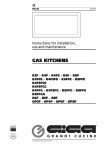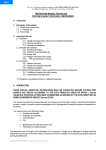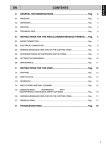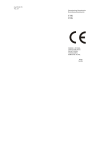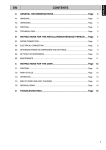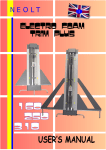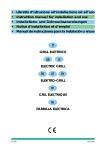Download dre-milano-p50-user-manual View Document
Transcript
DRE Milano P50 Podiatry Chair – Operating Manual 1. INTRODUCTION The successful and safe operation of the table-armchair is guaranteed only if it is used in accordance with the specifications in this manual and, in general, in accompanying documentation; therefore it is essential to carefully read and keep all the relative documentation. Although the armchair is equipped with active and passive safety features, not all risks can be avoided due to incorrect use. You must always make sure that all users have fully understood the rules of use; the manufacturer declines any responsibility for damage to persons or property resulting from improper use of the armchair. Do not remove or damage the labels, notices and warnings placed on side of the table. In case you need to restore them, please contact DRE. The manufacturer declines any and every responsibility for failure to observe the rules of safety and prevention described in the various section of this manual and for any damage caused by improper use. All work on the table (maintenance, adjustments, repairs, cleaning) must be carried out by suitably trained personnel and in accordance with what is indicated in this manual. 1.1. USE PURPOSE and WORKING LIFE The foot treatment chair DRE Milano P50 has been designed and built to perform professional treatments for foot care. WARNING! It is forbidden any use of the armchair other than that described in this manual. DRE declines any responsibility for malfunctions or damages to persons or property due to uses other than those specified in this manual. The table should be used only by personnel who are informed about the use, modes, operations, and its safety equipment. The estimated duration in service of this table is 10 years. 1.2. PRESERVATION OF THE MANUAL This operating manual should be kept for future reference. We recommend: a) Keep the manual in a place accessible and known to all operators, protected from moisture and heat and protected from direct sunlight; b) Use the manual in order not to damage any part of the content: do not remove, tear or modify for any reason parts of the manual. In the case of sale or transfer of the table to another person, this manual and its annexes should be delivered intact to the new users. WARNING! Please read this operation manual before using the armchair. Anyone who uses the table should be properly informed on the parts of this manual relevant to the operations to be performed. 1.3. LABELLING OF THE TABLE The table is equipped with labelling written in accordance with the Directives 2006/42/EC (machinery), 93/42/EEC (medical devices) and rule UNI CEI EN 980:2009. Data written on the label: • references of DRE; • marking ; • model and type; • serial number S N ); • year of manufacture WARNING! We recommend that you do not remove labels placed on the machine; labels should be kept securely fastened, kept intact and in good condition for readability. WARNING! The data shown on the data plates must be communicated in every need of assistance or spare parts. 1.4. WARNING MESSAGES SHOWN ON THE MACHINE The armchair is equipped with signs with warning symbols or signs showing caution phrases. Pay close attention to the instructions attached to the equipment. In correspondence with the input plug of power supply there is a warning symbol for the risk of electrocution. In correspondence with the movable parts there is the notice “Do not insert body parts or objects” (DON’T PUT YOUR FOOT ON - DON’T PUT OBJECTS ON) within the movement area of the armchair in order to avoid risk of crushing. WARNING! We recommend that you do not remove labels placed on the machine; labels should be kept securely fastened, kept intact and in good condition for readability. 2. TRANSPORT AND INSTALLATION 2.1. HANDLING AND REMOVAL FROM THE PACKAGING The armchair can be raised and moved manually by two or four people, carrying it by the base. The weight of the armchair is equal to 76 kg. The armchair is shipped packed and protected with spongy material (FOAM) in a cardboard box; open the box so you can freely raise the armchair as described above, remove it from the packaging by lifting it by means of the four support feet and picking it upwards. WARNING! All operation of transport and handling must be carried out by suitably trained personnel. WARNING! It is strictly forbidden to remove the product by lifting it from the top (mattress). WARNING! Do not use knives or box cutter to open the box so as not to risk damaging the armchair and in particular the padding. WARNING! Before its use, clear the entire armchair in accordance with the procedures described in § 6. 2.2. FLOORING The floor on which the armchair will be placed must be solid, smooth, horizontal and adequate to support the weight of the armchair and ensure stability. 2.3. LIGHTING The user must ensure that the lighting of the work area is sufficient to allow a good view of the operations and all elements of the armchair; the level of lighting should be in accordance with the UNI EN 12464-1:2004, in particular should avoid shadows and any annoying glare. 2.4. POSITIONING The position of the armchair compared to fixed obstacles must be such as to allow the easy passage for use and maintenance; in particular, the minimum space to allow the passage of persons shall be equal to 650 mm. In particular, to prevent crushing of the whole body the minimum distance between the leg rest fully raised or the back completely lowered and fixed obstacles must be equal to 500 mm. 2.5. LEVELING The foot treatment chair is equipped with four adjustable feet that allow you to level it perfectly and compensate for any imperfections in the flooring. The adjustment of the feet can be done simply screwing or unscrewing them. 2.6. POWER SUPPLY Voltage Frequency Power Absorption 100 / 110 / 230 V 50 / 60 Hz 160 W 1A max Fuses Transformer Power supply 2,5 A rit. (230 V ) - 4A (110 V ) - 6,3A (100V ) 120 V Monophase alternating current L+N GEARCASE IN CLASS II The system of power supply must have voltage and frequency equal to the rated voltage and frequency of the power supply of the armchair and be appropriate to the installed capacity, as indicated on the identification plate affixed on the same armchair. The power supply must be supplied to the armchair by a line: a) protected against overcurrent by an automatic circuit breaker (circuit breaker) or fuses, properly sized; the operating current of the protections must be as low as possible taking into consideration the maximum absorption of the armchair; b) equipped with a device sensitive to insulation failure (differential) with operating current low enough; this device must be positioned downstream of the overcurrent protective device (or be integrated with it); c) having cables with section suitable for the power absorbed by the armchair. The armchair must also be connected to an external unipotential protection circuit (grounding) adequate. 2.7. CONNECTIONS Insert the plug of the power supply cable into a suitable power outlet. If there is incompatibility between the socket and the plug of the armchair, replace the socket with a suitable type by professionally qualified personnel. Pull the plug from the power outlet grasping the plug, not the cable. WARNING! It is strongly recommended to insert the plug into a single outlet exclusively reserved to the armchair. We do not recommend the use of multiple sockets (power strip), adopters and patch cords. The cable must not be bent. WARNING! The armchair must be positioned so as to facilitate in any moment the disconnection of the plug from the power supply. WARNING! To avoid the risk of electric shock, this appliance must only be connected to a power supply with grounding. 2.8. ENVIRONMENTAL WORKING CONDITIONS AND STORAGE The foot treatment chair has been designed and built to operate in a closed and dry room. WARNING! The armchair was not designed to work in environments with explosive atmospheres, in the presence of fine dust or corrosive gases, in the presence of acids, corrosive agents, salt; it is also not suitable for operation in the presence of ionizing and non-ionizing radiation (x-rays, laser, microwaves, ultraviolet rays). The ambient operating conditions are: a) temperature: 5 - 40 °C; b) humidity: 30 % - 95 % without condensation If the environmental conditions are particularly critical it is advisable to provide the room with an adequate air conditioning system to bring the humidity and temperature values within acceptable limits . WARNING! Do not expose the armchair to an excessively humid environment. If the armchair gets wet, remove the plug from the outlet and have the armchair checked by an Authorized Service Center. The armchair has no special requirements for storage, provided that it takes place in closed and dry rooms; this condition should also be ensured during all phases of transport. WARNING! During the phase of storage and transport, keep the armchair in a dry place and do not leave it direct sunlight or next to heat sources. WARNING! For the correct functioning of the electrical equipment, the storage of the device must be at a temperature between -25°C - +55°C and, only for short periods not exceeding 24 hours, to +70°C. 2.9. PRELIMINARY CHECKS Before using the armchair, make sure that: a) there is no damage to the armchair due to transport and handling; eventually proceed to solve these problems by contacting DRE b) all packaging components have been removed; c) check that the supply voltage is equal to the rated one as defined in § 2.5; d) check the efficiency of the operation of the control equipment. Before using the armchair itself, run a few idling cycle tests, in conditions of safety, by qualified personnel. 3. DESCRIPTION Zak head Back rest Seat Leg rest Head adjustment knob Flat armrest Lifting arm Knob for lengthening legs Feet Rotation handle 3.1. ACCESSORIES ON REQUEST AND VERSIONS 3.1.1. AUTOMATIC ARMREST The automatic armrest (flat) is assembled with the screws supplied with the cover and padding. Place the pad on the metal part, assemble the cover and secure with the two screws 5x35, taking care to fit the cover to the padding. WARNING! The armrests have been designed exclusively to support the arm. It is strictly forbidden to sit or lay weight on the armrests. Any damage and replacements for improper use of the armrest will not be considered under warranty. 3.1.2. MANICURE BASINS (only for automatic armrests) Fix the support with the special butterfly at the end of each armrest and position the basin in the same support. 3.1.3. ROLL HOLDER The Milano P50 can be equipped with a roll holder to be fixed inserting the string of the roll holder into the screws already installed on the case of the back. 4. INSTRUCTION FOR USE 200 Kg (max. patient weight) = 2500 N (safety load) 4.1. OPERATOR AND CONTROLS The armchair Milano P50 is controlled by a pedal already connected. The operator must position themselves as to have complete view of the controller parts and of the patient. WARNING! During the functioning of the armchair the operator should always remain in the vicinity of the controls; it is forbidden to leave the armchair unattended during its operation. Operators should pay attention to avoid creating potentially dangerous situations for their own or other’s safety. All the people who work on the armchair must be properly trained on the correct methods of work and informed about its proper functioning. They also need to be aware of the parts of this document that are relevant to their work. The operators must not wear clothing with drapes that can be caught by the parts in motion of the device. Correct clothing is made from tight clothing, especially in regards to the upper limbs. Also should not wear rings, necklaces, bracelets, watches, ties or other objects that can be caught by the elements of the device in movement. WARNING! In case a patient has to be left alone for a short period it is necessary to place the armchair in the lowest position with respect to the floor so as to reduce the risk of injury in case of fall. CONTROL DESCRIPTION Base Up Base Down Back Up Back Down Trend Up Trend Down AUT FUNCTION Lifting of the armchair Descent of the armchair Lifting of the back Descent of the back Lifting tilt Descent tilt Automatic return to armchair position For the functioning of the legs it is necessary to press the S-button first – green LED on. S (SELECT) Right Leg Up Right Leg Down Left Leg Down Left Leg Up Right Leg Down + Left Leg Down Setting in motion of the pedal for operation of the legs (green LED on) Lifting of the right leg Descent of the right leg Descent of the left leg Lifting of the left leg Descent of both legs at the same time 4.2. ADJUSTMENT OF THE ZAK HEAD To extend/remove the Zak head, unscrew/screw the knob for head adjustment (fig. A). 4.5. LENGTHENING OF THE LEGREST Remember to bring the legs in the original position (fully shortened) before lowering them with the pedal or before using the AUT control. 4.6. ROTATION The armchair can rotate 90° to the right and 90° to the left. Turn the handle which is located under the seat. (see Fig. A) WITHOUT PRESSING THE COLOURED PUSH-BUTTON. Always make sure that the handle is closed and that the armchair is stopped before to let the patient sit down. NOTE: If the handle was in an awkward position, you can turn it into a more comfortable position by simply pulling it towards you and releasing it once settled. 4.7. UTILIZATION The capacity load of the armchair is 200 Kg and is indicated on the identification plate of the same. The armchair can fit only one person; the person must go up/get off when the armchair is in the basic position going up on the seat. IMPORTANT! For correct preservation of the mattress (and in particular the coating) and for hygienic reasons it is essential to cover and protect the mattress with disposable paper covering or washable towels. In fact, the coating may be damaged with the natural heat of the skin and with the prolonged use of essential oils or cosmetic products. Any replacements for damages caused by improper use will not be considered under warranty. WARNING! The limbs of the patient must always be on the armchair. The operator must always inform the patient when he moves the armchair. WARNING! Stretch out on the armchair always sitting properly in the central part of the seat. Do not sit or lean on the side of the feet or on the head. To avoid shock hazard, do not connect or disconnect the power plug with wet hands. Do not use the armchair barefoot. WARNING! If you smell an odor while the armchair is on, disconnect the cable and call the technical assistance. WARNING! Be careful to make sure that the armchair is not wet and that liquids do not remain on the armchair itself; immediately wipe up any liquids – including physiological liquids of the patient – which may end up on the armchair. 4.8. NOTICE TO THE OPERATORS AND RESIDUAL RISKS During movement the armchair can create zones of potential crushing: a) between the lower part of the seat and the lifting arm and between the lifting arm and the base; b) between the leg rest and the lifting arm: c) between the leg rest and the base. 5. MAINTENANCE The armchair has been designed and constructed so as to reduce as much as possible the necessary maintenance and ensure proper functioning over the years without any problems. During any intervention on the armchair, it is recommended to follow the instructions given in this section. WARNING! All interventions on the table must be carried out by competent and trained personnel on the methods to operate correctly and safety of the armchair. WARNING! Do not make any action on the armchair while moving, and always check that the plug connecting to power supply is disconnected; bring the power plug next to you during the execution of the intervention on the armchair so you can check at any time the actual separation. 5.1. GENERAL CHECKS Constantly check the general condition of the armchair and in particular the integrity of the safety and the electrical equipment. WARNING! Do not use the armchair if the component is found not to be perfectly intact or in service; put the table out of service by disconnecting the power plug immediately and contact an Authorized Service Center. 6. CLEANING Clean the armchair before each use, paying particular attention to remove all traces of physiological fluids of the previous patient. When cleaning, use a soft cloth and neutral detergent diluted in lukewarm water (if necessary a non-aggressive disinfectant) then wipe off with a clean dry cloth. Stains of oil, grease, ink must be removed immediately from the coating. Do not use products such as: ALCOHOL, BLEACH, THINNER, GASOLINE, SOLVENTS, ABRASIVE DETERGENTS. Jeans and other colored textiles may lose color and inevitably stain the coating. Be sure to always cover the padded parts with paper or towels. WARNING! Be careful not to spray liquids on the electrical equipment, on the pedal, and on the protections of the armchair. WARNING! You must follow the handling directions given in the safety data sheets of the detergent used. WARNING! During the cleaning of the machine some inhalable dust can be created, use appropriate protective mask and ensure adequate ventilation to the environment. The operators must follow the handling directions given in the safety data sheets of the chemical products used each time and use the appropriate personal protective equipment. 7. WARRANTY Product for professional use guaranteed for a period of 2 YEARS from the purchase date from an authorized dealer, that attest the date on which the sale was made. NOTE: The accessory HEATING OF THE MATTRESS is covered by warranty for 1 year from the purchase date. The warranty covers the replacement or repair of the parts of the armchair that are faulty due to factory defects. Are not under warranty all parts that may be defective due to negligence or carelessness in the use (non-observance of the operating instruction of the armchair), to improper installation or maintenance, maintenance carried out by unauthorized personnel, transport damages, or circumstances which, however, cannot be attributed to manufacturing defects of the armchair. Are also excluded from the warranty services, the interventions regarding the installation and connection to the power supply (which must be performed by qualified personnel). The warranty is excluded in all cases of improper use of the armchair. The manufacturer declines all responsibility for any damage that may directly or indirectly result from people, objects and pets as a result of failure to observe all of the instructions given in the booklet and especially concerning the warnings regarding installation, use and maintenance of the armchair. The warranty will also be void, in case of non-observance of the terms of payment. The aforesaid warranty covers products for professional use. 8. EXTRAORDINARY MAINTENANCE Any extraordinary maintenance must be performed by qualified personnel at DRE's technical service or authorized Service Center. Information about the Authorized Service Center to which you can turn, can be obtained directly from DRE. For a correct and quick resolution of the problem, it is necessary to communicate to DRE the model and the serial number of the armchair and the description of the defect, that is, what are the visible problems, and under what condition it occurs. The broken armchair, if under warranty, must be sent to the Service Center together with the certificate of guarantee, transport charges must be paid for by the purchaser. WARNING! Any form of warranty expires if interventions are carried out on the armchair by someone not authorized by DRE. 9. SPARE PARTS All the spare parts must be requested by DRE and will supply them directly or will give you indications on the place where they can be found. Please note that any extraordinary maintenance must be performed by personnel of DRE or authorized by them. WARNING! Any form of warranty expires if spare parts other than those originally fitted on the armchair are used. 10. NOISE PRODUCED FROM THE ARMCHAIR The level of acoustic radiation pressure continuous equivalent weighted A emitted by the appliance is less than 70 dB(A). The measurement was carried out on the device during normal functioning with a patient weighing about 80 kg. The maximum acoustic radiation pressure is equal to 80,5 dB(C) and has been detected in the vicinity of the motors. The detection of the airborne noise was carried out according to the rule UNI EN ISO 11202:1997. 11. DISMANTLING If the armchair becomes inoperative or is not to be used for an extended period of time, it is recommended to remove it from service and remove the plug from the socket. This armchair is manufactured with components in steel and plastics: so much of the materials are effectively recyclable. All materials used to manufacture the armchair are not toxic or hazardous to the health of operators, so they can be handled without special precautions. 12. DISPOSAL OF OBSOLETE EQUIPMENT This product must be disposed of separately from the municipal service through collection facilities appointed by the Government or the Local Authorities. The correct disposal of the obsolete equipment will help to prevent potential negative effects on human health and the environment. WARNING! The dismantling of the armchair at the end of its useful life must be carried out be personnel competent and trained on the proper ways of handling – and eventually dismantling – the armchair. Use only equipment and suitable lifting devices in conformity to the regulations and law in force. For information, contact your Local Council or the Waste Disposal Service. WARNING! Having to disassemble the armchair for transfer to another site, please contact DRE. 13. LIST OF THE RULES • Directive 2006/42/EC of the European Parliament and of the Council of 17 May 2006 on machinery, and amending Directive 95/16/EC (recast) • Directive 2006/95/EC of the European Parliament and of the Council of 12 December 2006 on the approaching of the laws of the Member States relating to electrical equipment to be used within certain voltage limits. • Directive 2004/108/EC of the European Parliament and of the Council of 15 December 2004 on the approaching of the laws of the Member States relating to the electromagnetic compatibility. • UNI EN ISO 12100-1 (2009): Safety of machinery. Basic concepts, general principles for design. Part 1: Basic terminology, methodology • UNI EN ISO 12100-2 (2009): Safety of machinery. Basic concepts, general principles for design.Part 2: technical principles. • UNI EN ISO 13857 (2008): Safety of machinery. Safety distances to prevent the contact of dangerous areas with upper and lower limbs. • UNI EN 349 (2008): Safety of machinery. Minimum gaps to avoid crushing of parts of the human body. • CEI EN 60204-1:2006-09: Safety of machinery. Electrical equipment of machines. Part 1: General requirements. • UNI EN ISO 11202:2010 “Acoustics – Noise emitted by machinery and equipment – Determination of emission sound pressure levels at a work station and at other specified positions applying approximate environmental corrections”. This publication or parts thereof may not be reproduced, stored in a storage machine, transmitted, transcribed, or translated into any language, usual or computer, in any form or by any means, electronic, mechanical, magnetic, optical, chemical, manual or otherwise, without the express written permission of DRE shall provide warranty with respect to the contents of this publication, with the express prohibition of the use of the same publication for any other purpose whatsoever, commercial, practical, technicalscientific, unrelated to the functioning of the equipment to which it relates for which this issue has been written. The warranty on the accuracy of the information contained herein is provided on condition that they are strictly observed by the user of the device, all the prescriptions contained in this documentation. Moreover DRE reserved the right to revise this publication and to make changes in the content without obligation to notify any person or organization. These revised publications are available on request by DRE.





















